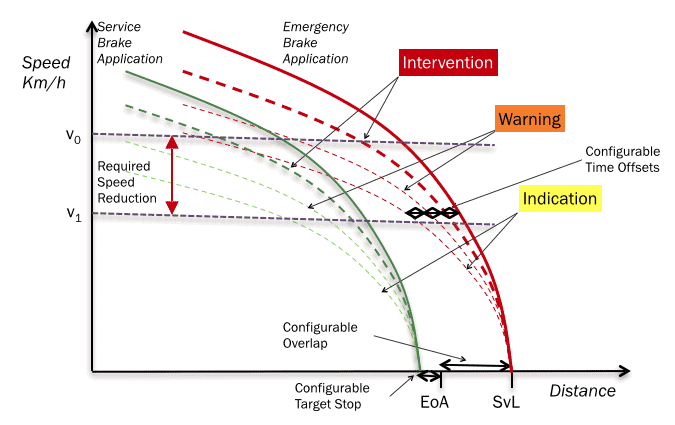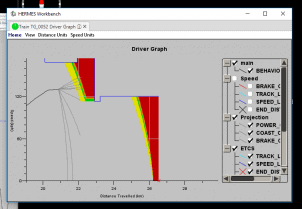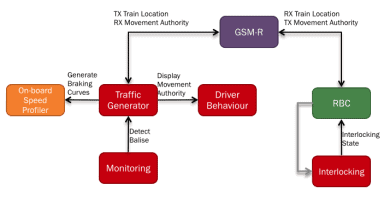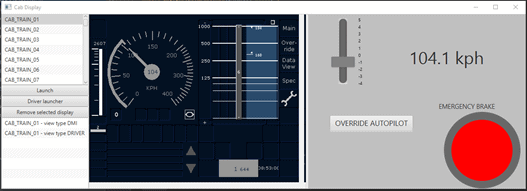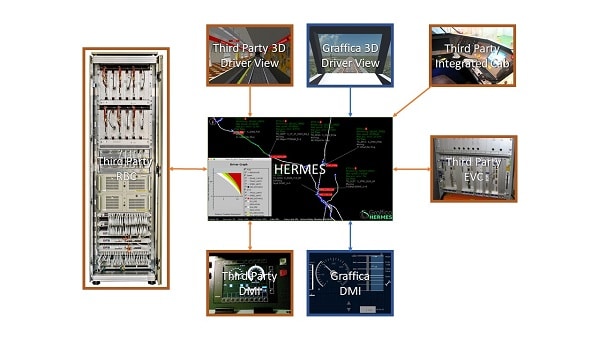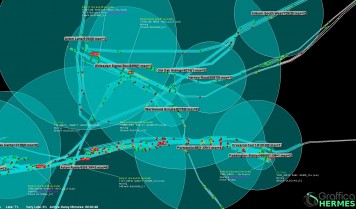How Network Rail are using HERMES to model future ETCS implementations
Overview
The European Train Control System (ETCS) defines a European standard for railway signalling and train protection systems. With the advent of high speed international trains, it has become essential to ensure the interoperability of signalling safety systems across the network.
Graffica has worked with Network Rail to produce a high fidelity representation of the ETCS Level 2 system and Level 3 virtual block systems in accordance with the 3.6.0 SRS, with ongoing development to produce a Level 3 moving block simulation.
Levels of ETCS
Level 0: no line-side ETCS equipment installed, so ETCS compliant vehicles will be managed through the conventional non-ETCS equipment.
Level 1: line-side ETCS equipment installed (possibly as an overlay to conventional non-ETCS systems) and on-board; transmission of data from track to train via ETCS balises placed at fixed locations along the track.
Level 2: RBC (control centre) communicating with on board using GSM-R, using the on-board equipment to supervise speed and braking, and a combination of track-side equipment and the on-board to supervise train location.
Level 3: as level 2, but train location and train integrity supervision are handled by equipment on the train, and no longer rely on track-side equipment such as track circuits or axle counters.
ETCS Modelling with HERMES
The HERMES Level 2 ETCS model uses the conventional interlocking definitions, but replaces the signals with marker boards and places additional balise groups at definable locations on the track. The simulator also models the onboard European Vital Computer (EVC). The ETCS onboard model is fully parameterised with standard ETCS train data, enabling the EVC to be emulated and run alongside the HERMES driver and vehicle performance models. The driver model attempts to keep the train speed at the resultant target ETCS braking curve and the on-board will intervene if the relevant braking curves are breached.
Other parametric aspects of the model include the ETCS National Values and if necessary the Fixed Values.
Graffica is working with Network Rail to assess the likely impact of ETCS deployment on train schedules, particularly the braking profiles of freight trains, which require extended brake application times. The detailed simulation examined the effects of different driver behaviour models; in particular, the response to changes in movement authority where the driver had little or no route knowledge (reactive driver behaviour) and a response based on good route knowledge (predictive driver behaviour).
“The development of HERMES for the ERTMS project in the UK has been a hugely beneficial endeavour allowing us to simulate a future design of railway with a level of accuracy unseen in the industry to date. Network Rail and Graffica are collaborating successfully to streamline the project and create an accessible and powerful modelling tool.”
– Thomas Harrison (ETCS Systems Engineer, Network Rail)
The HERMES ETCS Model
HERMES models ETCS with a number of independent software components representing the Radio Block Centre (RBC), the mobile communications (GSM-R) and the train-borne computer (EVC).
HERMES ETCS Profile Display
The RBC model maintains the location of each connected and registered train, as well as managing interlocking state information. This relays the current limit of the train movement authority in response to position updates received from the trains as they pass fixed points on the track marked by balises. The balises allow the RBC to map the position updates onto actual locations on the track.
When operating in Level 3 Virtual Block mode, the RBC divides each physical block into multiple “virtual” blocks. The operating principle is the same except that there is no track-side detection of trains within the blocks; instead the on-board’s position updates and train integrity reports are used.
The EVC continuously calculates safe braking curves from the current speed and using the track speed and gradient profile of the track ahead provided by the RBC.
HERMES ETCS Functional Representation
Driver Advisory Model
The Driver Advisory System (DAS) model in HERMES provides a mechanism to provide driving instructions for the train either as an advisory when under driver control, or as a traction requirement in Automatic Train Operation (ATO). The current DAS implementation has been developed in support of the European Commission FP7 ON-TIME project.
HERMES Driver Working Position
Interoperability and the HERMES API
HERMES is constructed from a set of components, each of which models a distinct functional aspect of the railway. This requires each component to provide a well-defined interface to enable the other components to interact and exchange information with that component in real-time. This is called the HERMES business API, and while decoupling the functional aspects of the railway it also enables a high degree of interoperability for component implementations, specifically it permits the substitution of specific algorithms, high or low fidelity models and the general expansion of the platform to extend its functional scope without the need for major re-engineering of the software framework.
The public API allows third-party systems, such as a live RBC or a driving cab environment, to connect seamlessly. The driving cab might be an integrated cab provided by a third party or developed partially or wholly by Graffica: the company has developed a prototype “vanilla” ERTMS DMI which may be configured or extended to meet a particular client requirement. Alternatively a third party DMI could be connected. Graffica also have 3D display capability which has been used in the air traffic domain, which could also be driven by the HERMES simulator; or it could be used to drive a third-party 3D display.
HERMES Interoperability with 3rd Party Systems
Developments
Graffica are developing a prototype ETCS Level 3 Moving Block model. This is a more efficient signalling paradigm where the “blocks” of reserved track move with the train. The train’s most recently reported position is used as the rear of the block, and its movement authority forms the front of the block, with added safety margins. The train can always stop within its movement authority (enforced by the EVC); and the RBC will attempt to extend it far enough ahead that the train can drive at full speed.
We have also developed a model of ATO (Automatic Train Operation) over ETCS where automated driving is used to enhance capacity and journey times, and save energy. Where necessary to meet the timetable, ATO will drive the train as aggressively as possible without triggering an ETCS intervention; and when the timetable includes slack time, that will be used to drive in a more energy efficient manner.
In Level 3, there are no physical signalling control blocks. Instead the blocks may vary in length and location, or may be implemented as a virtual fixed block system with the same interlocking controls as a conventionally signalled system. The HERMES generic Level 3 model will enable users to configure the block system of choice, providing the flexibility to model a range of solutions.
